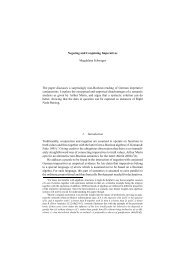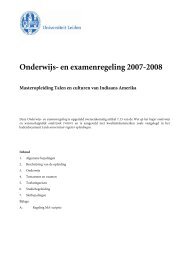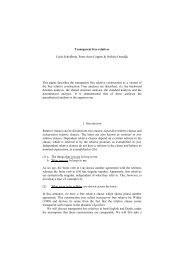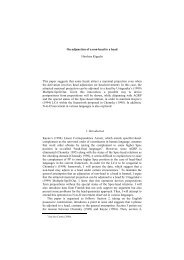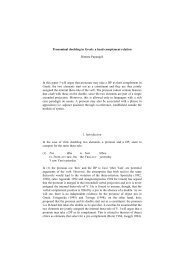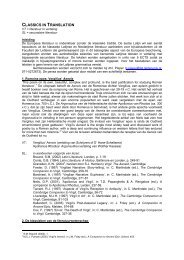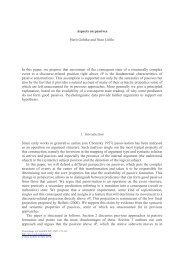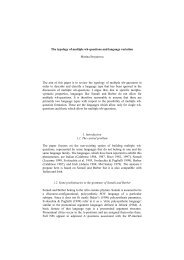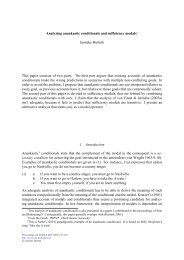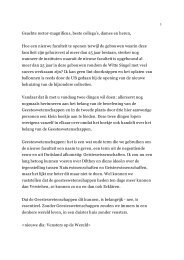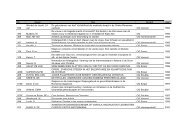The interface between morphology and phonology
The interface between morphology and phonology
The interface between morphology and phonology
Create successful ePaper yourself
Turn your PDF publications into a flip-book with our unique Google optimized e-Paper software.
<strong>The</strong> <strong>interface</strong> <strong>between</strong> <strong>morphology</strong> <strong>and</strong> <strong>phonology</strong><br />
Geert Booij<br />
Abstract<br />
In this paper, a comment on Kaisse’s article on the role of <strong>phonology</strong> in English word formation, a<br />
range of phenomena is discussed that confirm Kaisse’s conclusion that “the relation <strong>between</strong> word<br />
formation <strong>and</strong> <strong>phonology</strong> is complex”. <strong>The</strong> article deals with a number of types of interaction <strong>between</strong><br />
<strong>morphology</strong> <strong>and</strong> <strong>phonology</strong>, in particular prosodic determinants of the shape of bound morphemes, the<br />
way in which affixes compete, <strong>and</strong> restrictions on stacking up affixes. <strong>The</strong> data are taken mainly from<br />
Dutch.<br />
1. Introduction<br />
This contribution is a comment on Ellen Kaisse’s chapter ‘Word formation <strong>and</strong> <strong>phonology</strong>’ in<br />
the H<strong>and</strong>book of English Word-formation edited by Pavol Štekauer <strong>and</strong> Rochelle Lieber.<br />
<strong>The</strong> basic claim by Kaisse is that “the morphological make-up of a word has<br />
considerable influence on its pronunciation” (p. 1). This is a very essential claim as to how<br />
<strong>morphology</strong> interacts with <strong>phonology</strong> that Kaisse convincingly shows to be correct on the<br />
basis of data from English.<br />
A particular model of how <strong>morphology</strong> interacts with <strong>phonology</strong> is the theory of<br />
Lexical Phonology that Kaisse discusses in detail. This theory comprises a set of hypotheses<br />
of which the two most important ones are the following (cf. Booij 2000 for a survey):<br />
(1) (i) <strong>morphology</strong> <strong>and</strong> (lexical) <strong>phonology</strong> apply in t<strong>and</strong>em;<br />
(ii) there is a distinction <strong>between</strong> lexical <strong>and</strong> post-lexical <strong>phonology</strong>.<br />
<strong>The</strong> first assumption is essential for so-called cyclicity effect, <strong>and</strong> also makes the correct<br />
prediction that derived phonological properties of stems may be relevant in word formation<br />
(examples from Dutch are given in Booij 1995: Chapter 5). <strong>The</strong> relevance of the distinction<br />
<strong>between</strong> lexical <strong>and</strong> post-lexical <strong>phonology</strong> carries over to non-derivational frameworks such<br />
as Optimality <strong>The</strong>ory, as argued in Booij (1997), Hermans <strong>and</strong> Van Oostendorp (eds., 1999),<br />
Kiparsky (2000), <strong>and</strong> Ito <strong>and</strong> Mester (2001).<br />
<strong>The</strong> theory of Lexical Phonology is usually associated with a third hypothesis as well,<br />
that of level ordering. Level ordering is a mechanism for expressing constraints on affix<br />
ordering, <strong>and</strong> the correlation <strong>between</strong> the order of affixes <strong>and</strong> their phonological behaviour.<br />
For instance, for English it has been claimed that stress-neutral suffixes are peripheral to<br />
stress-shifting suffixes. Level ordering, if a sustainable claim at all, is certainly languagespecific<br />
in nature since languages may differ in the number of levels they have, <strong>and</strong> they may<br />
exhibit no level ordering at all. For English, Kaisse assumes two classes of suffixes, cohering<br />
<strong>and</strong> non-cohering suffixes. This distinction is also referred to as class I versus class II<br />
suffixes, or stress-affecting versus stress-neutral suffixes. Some examples of these two classes<br />
of suffixes as given by Kaisse are listed in (2):<br />
(2) a stress-shifting suffixes: -age, -al, -ant, -ance, -ary, -ate, -ic, -ion;<br />
b stress-neutral suffixes: -able, -er, -en, ful, -hood, -ish, -ism, -less, -like, -ment.<br />
A serious problem for this classification (pointed out in Booij (1977) for similar suffixes of<br />
Dutch, <strong>and</strong> reiterated by Raffelsiefen (2005) for English) is that the set of stress-neutral<br />
suffixes does not coincide with the class of non-cohering suffixes if we take the latter notion
seriously. <strong>The</strong> vowel-initial stress-neutral suffixes listed in (2b) such as -er <strong>and</strong> -able behave<br />
in fact as cohering suffixes, like the suffixes in (2a). A cohering suffix is a suffix that does not<br />
form a prosodic domain of its own, but forms one prosodic word with the stem to which it is<br />
attached. Such behaviour is exhibited by stress-neutral suffixes of English such as -er <strong>and</strong><br />
-ing, as can be seen from the syllabification patterns of words with these suffixes: ba.ker,<br />
ba.king (the dots indicate syllable boundaries). <strong>The</strong> distinction cohering / non-cohering has<br />
been introduced by Dixon (1977: 93); cf. also Booij 2005: 162-165). On the other h<strong>and</strong>, the<br />
consonant-initial suffixes in (2b) do behave as non-cohering: they either form a prosodic word<br />
of their own (for instance, -ful <strong>and</strong> –hood), or they form an extra syllable adjoined to the<br />
prosodic word node of the stem, as in the case of -ness (the suffix -ness /ns/ cannot form a<br />
prosodic word of its own since it lacks a full vowel) <strong>and</strong> -less.<br />
Raffelsiefen’s work in this domain (cf. Raffelsiefen 2005) is discussed by Kaisse in<br />
relation to Paradigm Uniformity effects. As Raffelsiefen argues, to my mind convincingly, the<br />
influence of morphological structure on the phonetic realisation of complex words is mediated<br />
by the prosodic structure of such words. First we map morphological structure onto prosodic<br />
structure, <strong>and</strong> subsequently the relevant prosodic constituents form the domain of<br />
phonological rules or constraints (cf. Booij 2005, Chapter 7 for general discussion of this<br />
point). Thus, many phonetic similarities <strong>between</strong> derived words <strong>and</strong> their stems can be<br />
explained, without making use of output-output conditions as used in Optimality <strong>The</strong>ory.<br />
Kaisse rightly concludes that Level Ordering is not the right mechanism for expressing<br />
restrictions on affix combinations in English. However, we should realize that rejecting Level<br />
Ordering does not imply rejection of the basic tenets of Lexical Phonology as summarized in<br />
(1).<br />
<strong>The</strong> basic comment that I have on Kaisse’s paper is that it focuses on one type of<br />
interaction <strong>between</strong> word formation <strong>and</strong> <strong>phonology</strong>, the influence of morphological structure<br />
on the phonetic shape of complex words. In this contribution I would like to draw attention to<br />
other forms of interaction <strong>between</strong> word formation <strong>and</strong> <strong>phonology</strong>, in particular the<br />
phonotactics of bound morphemes, phonologically motivated periphrasis, the role of<br />
phonological output conditions in making a choice <strong>between</strong> competing affixes, <strong>and</strong> the<br />
relevance of prosodic properties of affixes for their combinability.<br />
2. <strong>The</strong> phonotactics of affixes<br />
A classic observation by Roman Jakobson is that lexical morphemes differ in their<br />
phonotactics from grammatical morphemes, including affixes. For instance, the following<br />
generalisation can be made with respect to the phonotactic properties of Dutch lexical<br />
morphemes: they do not begin with a schwa-headed syllable, <strong>and</strong> they do not contain sequences<br />
of schwa-headed syllables. That is, the following configurations are not allowed within lexical<br />
morphemes:<br />
(3) a .. .. V..<br />
b .. V .. .. <br />
<strong>The</strong> only exceptions are French loanwords such as the following tha begin with a schwa-headed<br />
syllable:<br />
(4) b[]sógne `task'<br />
b[]tón `concrete'<br />
l[]gáat `legacy'
<strong>The</strong> driving force behind these constraints is that the optimal prosodic shape of a Dutch word of<br />
one of the lexical categories should be such that it can be parsed into one or more feet, without<br />
any syllable left over. <strong>The</strong> preferred Dutch foot is a trochee, a disyllabic foot of which the first<br />
one is the head <strong>and</strong> carries some degree of stress. Feet can, however, be monosyllabic if they<br />
contain a full vowel, <strong>and</strong> have a certain minimum weight, that of two moras. Hence, the<br />
configurations in (3) will lead to prosodic structures in which the first or the last syllable cannot<br />
be parsed into a foot <strong>and</strong> thus leads to a prosodically less optimal structure. In complex words,<br />
however, we do find such prosodic structures due to the attachment of a prefix that consists of a<br />
schwa-headed syllable such as be- /b/ or a schwa-containing suffix such as -er /r/. This is in<br />
line with Kaisse’s observation: <strong>morphology</strong> may create structures that are less optimal from the<br />
phonological point of view. Thus, <strong>morphology</strong> appears to be ranked above <strong>phonology</strong>.<br />
Another phonological constraint of Dutch is that prosodic words (correlating with either a<br />
simplex or a complex word) cannot begin with a schwa. This is an inviolable condition. <strong>The</strong><br />
consequence of this constraint is that if a morpheme begins with a schwa, it must be either a<br />
suffix or an enclitic. Suffixes <strong>and</strong> enclitics attach prosodically to the left, <strong>and</strong> hence this schwa<br />
will be syllabified with the preceding stem or word into one prosodic word. Thus, violation of<br />
this exceptionless constraint is avoided.<br />
An additional relevant observation is that a Dutch prosodic word consists of one of more feet<br />
optionally followed by an appendix of coronal obstruents. A similar generalization can be made<br />
for English. Hence, there are Dutch <strong>and</strong> English suffixes that consist of consonants only, -s, -t,<br />
<strong>and</strong> -st, since such suffixes can be accommodated in the prosodic structure of words. On the<br />
other h<strong>and</strong>, there are no consonantal prefixes since there is no appendix position at the<br />
beginning of prosodic words that could accommodate such consonants. Moreover, consonantal<br />
suffixes can only consist of -s-, -t, <strong>and</strong> combinations thereof, since other consonants cannot be<br />
accommodated by a word-final appendix position. In short, the shape of affixes is codetermined<br />
by the prosodic constraints of the language, an important general claim about the<br />
way in which <strong>phonology</strong> interacts with <strong>morphology</strong>.<br />
This point is also relevant for the distinction <strong>between</strong> cohering <strong>and</strong> non-cohering affixes.<br />
Non-cohering affixes are in most cases prosodic words of their own. This is reflected by their<br />
phonological make-up: they begin with a syllable headed by a full vowel, <strong>and</strong> can thus form a<br />
proper prosodic word of their own.<br />
3. Phonologically motivated periphrasis<br />
Periphrasis, the expression of certain cells of a morphological paradigm by means of multiword<br />
units, may be conditioned by <strong>phonology</strong>. English is a straightforward case of such a<br />
language. <strong>The</strong> comparative form of adjectives is only synthetic if the stem is monosyllabic<br />
(warm - warmer), or bi-syllabic with a light second syllable, as in silly - sillier. This is an<br />
example of a phonological input condition on <strong>morphology</strong>. In the case of Dutch, it is prosodic<br />
output considerations that determine the choice <strong>between</strong> synthetic <strong>and</strong> analytic form of the<br />
comparative. <strong>The</strong> comparative <strong>and</strong> the superlative form may be expressed in a periphrastic<br />
form, by making use of the adverbs meer ‘more’ <strong>and</strong> (het) meest ‘most’ respectively (het is<br />
omitted after a determiner). <strong>The</strong> choice for the periphrastic form of the superlative form in<br />
Dutch is partially governed by phonological output conditions. With adjectival stems ending<br />
in -isch /is/, -sk, -st phonetically complex <strong>and</strong>/or opaque forms can thus be avoided:<br />
(5) bruusk ‘sudden’ *bruusk-st [bryskst] / meest bruusk<br />
log-isch ‘logical’ ?logisch-st [lo:gist] / meest logisch
vast ‘solid’<br />
*vast-st [vastst] / meest vast<br />
<strong>The</strong> second example carries a question mark since speakers of Dutch hesitant with respect to<br />
the well-formedness of this form. Indeed, in itself the cluster /st/ is not bad at the end of a<br />
prosodic word after a vowel, yet speakers tend to avoid this superlative form, may be because<br />
the suffix -st is not realized completely due to degemination. For the two other cases, it will<br />
be clear that the word-final consonant sequences are tongue twisters that cry for a periphrastic<br />
alternative.<br />
4. Competing affixes<br />
<strong>The</strong> choice <strong>between</strong> competing affixes may be determined by prosodic output conditions. A<br />
good example in the domain of word formation is the competition in Dutch <strong>between</strong> the<br />
deverbal nominalizing suffixes -er <strong>and</strong> -aar (discussed in detail in Booij 2005: 172-175 on<br />
which the text here is based).<br />
<strong>The</strong>se two suffixes look like allomorphs in the sense that they are phonologically<br />
similar. However, it is not possible to assign them a common underlying form, <strong>and</strong> derive the<br />
two surface forms by means of well-motivated general phonological rules or constraints of<br />
Dutch. <strong>The</strong>re is no general phonological constraint for Dutch that vowels in word-final<br />
unstressed syllables must be reduced to schwa. Hence, -er cannot be derived phonologically<br />
from -aar. So in fact you can see them as competing affixes: different affixes with the same<br />
meaning <strong>and</strong> domain of application.<br />
<strong>The</strong> basis for choosing <strong>between</strong> the suffixes -er <strong>and</strong> -aar is the following: -aar is used<br />
after a stem ending in an unstressed syllable, with /l/,/r/, or /n/ as its final consonant (these are<br />
the coronal sonorant consonants of Dutch); -er is used elsewhere.<br />
(6) bedel /be:dl/ ‘to beg’ bedel-aar /be:dla:r/ ‘begger’<br />
luister /lüystr/ ‘to listen’ luister-aar / lüystra:r/ ‘listener’<br />
reken /re:kn/ ‘to compute’ reken-aar /re:kna:r/ ‘computer’<br />
bezem /be:zm/ ‘to sweep’<br />
verdedig /vrde:d/ ‘to defend’<br />
bak /bk/ ‘to bake’<br />
bezem-er /be:zmr/ ‘sweeper’<br />
verdedig-er /vrde:dr/ ‘defender’<br />
bakk-er /bkr/ ‘baker’<br />
It is possible to account for this pattern by assigning a phonological subcategorization feature<br />
to the suffix -aar that specifies its restricted distribution (only after stem-final coronal<br />
sonorants preceded by a schwa). <strong>The</strong> suffix -er does not need to have such a subcategorization<br />
feature: it is the default suffix that can be used elsewhere. <strong>The</strong> priority of -aar above -er for<br />
verbs ending in an unstressed syllable with /l,r,n/ can be taken care of by Panini’s Principle. In<br />
the case of the base word bedel the suffix -aar will be selected, <strong>and</strong> hence suffixation with -er<br />
is excluded. <strong>The</strong> base word bezem, on the other h<strong>and</strong>, although it ends in an unstressed<br />
syllable, does not end in a coronal sonorant since the /m/ is a labial consonant. Thus,<br />
attachment of -aar is impossible, <strong>and</strong> -er will be attached.<br />
This analysis can be qualified as an analysis that makes use of input constraints: each<br />
competing suffix imposes certain requirements on its input forms. <strong>The</strong> drawback of such an<br />
analysis is that it does not provide any explanation for this particular selection pattern. <strong>The</strong><br />
factor behind this pattern is the avoidance of a sequence of two unstressed syllables. If we<br />
added -er after an unstressed syllable, we would get a sequence of two unstressed syllables.
Consider the word reken-aar <strong>and</strong> its ill-formed counterpart reken-er. <strong>The</strong>ir prosodic<br />
structure in terms of syllables <strong>and</strong> feet will be as follows (syllable boundaries indicated by<br />
dots):<br />
(7) a. (re:.k) F (na:r) F<br />
b. (re:.k.) F nr<br />
In (7b), the last syllable cannot be made part of a foot (that is, cannot be parsed into a foot),<br />
because it does not have a full vowel. Hence, (7a) is better from the point of view of prosodic<br />
structure. This prosodic structure correctly implies that the last syllable also bears a degree of<br />
stress, i.e. secondary stress.<br />
This selection process of competing allomorphs can be modelled in terms of<br />
optimality-theoretical tableaux: each combination of a stem <strong>and</strong> an allomorph is a c<strong>and</strong>idate,<br />
<strong>and</strong> the ranked set of phonological constraints will determine the optimal c<strong>and</strong>idate. <strong>The</strong><br />
advantage of this theory is that it makes uses of output constraints. <strong>The</strong> crucial constraints<br />
involved here are ParseSyll, Foot-Min, <strong>and</strong> Foot-Max. ParseSyll requires syllables to be made<br />
part of feet, Foot-Max requires feet to be maximally binary, <strong>and</strong> FootMin requires feet to be<br />
minimally binary. Note that we cannot parse the last syllable of rekener into a foot since it has<br />
no full vowel.<br />
/re:kn + a:r or r/ ParseSyll FootMax FootMin<br />
(re:.k) F (na:r) F *<br />
(re:.k.) F na:r *!<br />
(re:.k.) F nr *!<br />
(re:.k.nr) F *!<br />
Table 1. OT-tableau for rekenaar<br />
<strong>The</strong> ranking of ParseSyll <strong>and</strong> FootMax is not crucial in these cases. What is crucial is that<br />
these two are ranked higher than FootMin. As a result of this ranking, the first c<strong>and</strong>idate is<br />
designated as the optimal one.<br />
In the analysis outlined here, the selection of these two competing suffixes is done by<br />
output constraints. Such constraints thus appear to play an important role in the <strong>interface</strong><br />
<strong>between</strong> <strong>morphology</strong> <strong>and</strong> <strong>phonology</strong>: <strong>morphology</strong> provides a number of alternatives,<br />
equivalent from the morphological point of view, <strong>and</strong> the <strong>phonology</strong> then computes which of<br />
them is optimal from the phonological point of view (cf. Carstairs 1988, Rubach <strong>and</strong> Booij<br />
2001).<br />
This does not mean that phonological subcategorization constraints are superfluous.<br />
For instance, we still have to state that -aar can only occur after stems ending in a coronal<br />
sonorant consonant (that is, /l/, /r/, or /n/). <strong>The</strong>refore, the deverbal noun for bezem ‘to sweep’<br />
is bezemer ‘sweeper’ even though this deverbal noun contains a sequence of two unstressed<br />
syllables.<br />
Note that these constraints are all violable as we saw above. For instance, Dutch<br />
diminutives such as ball-etje [bltj] ‘ball, dim.’ <strong>and</strong> kamm-etje [kmtj] ‘comb, dim.’ end<br />
in a sequence of two unstressed syllables, <strong>and</strong> hence ParseSyll will be violated. In this case<br />
there is no morphological alternative that can be used to avoid this violation. In other words,<br />
when necessary, <strong>morphology</strong> takes precedence over <strong>phonology</strong>, even if this leads to less<br />
optimal phonological structures.
5. Affix ordering<br />
<strong>The</strong> ordering of affixes <strong>and</strong> the restrictions on their combination within complex words is one<br />
of the traditional topics of <strong>morphology</strong>. Recently, new attempts have been made to find<br />
generalizations for restrictions on stacking up affixes, in particular Hay (2002) for English,<br />
<strong>and</strong> Aronoff & Fuhrhop (2002) for English <strong>and</strong> German. In Booij (2002) I argued that<br />
phonological properties of affixes play a role in accounting for the restrictions on affix<br />
sequences in Dutch. This is another example of how <strong>phonology</strong> influences <strong>morphology</strong>.<br />
Let us assume the following hypothesis:<br />
(8) <strong>The</strong> more it leads to violations of prosodic output conditions, the more attachment of<br />
an affix will be avoided.<br />
<strong>The</strong> native suffixes of Dutch divide phonologically into two classes: non-cohering <strong>and</strong><br />
cohering suffixes, whereas the non-native, Romance ones are all cohering. Recall that the<br />
distinguishing property of non-cohering suffixes is that they form a prosodic word of their<br />
own, <strong>and</strong> do not form a prosodic word together with the stem to which they attach. <strong>The</strong> set of<br />
non-cohering suffixes of Dutch is listed <strong>and</strong> exemplified in (9):<br />
(9) Non-cohering suffixes<br />
-achtig /axt/<br />
-baar /ba:r/<br />
-dom /dm/<br />
-heid /hεid/<br />
-ling /l/<br />
-loos /lo:z/<br />
-schap /sxp/<br />
-zaam /za:m/<br />
rood-achtig 'reddish'<br />
eet-baar 'edible'<br />
adel-dom 'nobility'<br />
schoon-heid 'beauty'<br />
naar-ling 'unkind person'<br />
draad-loos 'wireless'<br />
vriend-schap 'friendship'<br />
deugd-zaam 'virtuous'<br />
<strong>The</strong> non-cohering nature of these suffixes is illustrated by the contrast <strong>between</strong> the suffix -<br />
achtig <strong>and</strong> its cohering semantically equivalent counterpart, the suffix -ig; both occur with the<br />
adjectival stem rood 'red', <strong>and</strong> contribute the same meaning '-ish', but show different<br />
phonological behaviour:<br />
(10) rood-achtig [ro:t.x.tx] rodig [ro:.dx]<br />
Since -achtig forms a prosodic word of its own, it is an independent domain of syllabification.<br />
Hence, the /d/ of rood occurs in syllable-final position, <strong>and</strong> is devoiced due to the constraint<br />
Final Devoicing (obstruents are voiceless in coda position). On the other h<strong>and</strong>, the suffix -ig is<br />
cohering, <strong>and</strong> forms one prosodic word with its base. <strong>The</strong>refore, the morpheme-final /d/ of<br />
rood fills an onset position in rodig, <strong>and</strong> will be thus exempted from Final Devoicing, <strong>and</strong><br />
remains voiced.<br />
<strong>The</strong> role of prosodic structure in stacking up affixes can be observed for the noncohering<br />
suffixes -dom <strong>and</strong> -schap. <strong>The</strong>se suffixes can be followed by schwa-initial cohering<br />
suffixes, even by the suffix -elijk /lk/ with its two schwa-headed syllables:<br />
(11) weten-schapp-elijk 'scientific', l<strong>and</strong>-schapp-elijk 'l<strong>and</strong>scape-', maat-schapp-elijk<br />
'societal', vriend-schapp-elijk 'friendly', weten-schapp-er 'scientist', bood-schapp-er<br />
'messenger', christen-domm-elijk 'christian'
<strong>The</strong> non-cohering suffixes begin a new prosodic word, <strong>and</strong> hence such words with two<br />
suffixes are prosodically not more marked than words consisting of a simplex stem followed<br />
by the suffix -elijk as in vriend-elijk [vrindlk] 'friendly'.<br />
Languages tend to have their inflectional endings peripheral to derivational<br />
morphemes, <strong>and</strong> this may be seen then as a general principle on affix ordering. However, as<br />
shown in Booij (1993, 1996), there are systematic exceptions to this generalization in Dutch.<br />
In particular, inherent inflection such as pluralization of nouns, comparative forms, <strong>and</strong> the<br />
formation of non-finite forms of verbs may precede the attachment of non-cohering<br />
derivational suffixes. Such inflectional endings never occur before cohering derivation<br />
suffixes. <strong>The</strong> effect is that inflectional endings will always occur at the right edge of a<br />
prosodic word. <strong>The</strong> following data from Dutch show that inherent inflection can indeed feed<br />
certain types of derivation;<br />
(12) plural nouns<br />
boeken ‘books’<br />
boeken-achtig ‘bookish’<br />
meisjes 'girls'<br />
meisjes-achtig 'girlish'<br />
helden ‘heroes’<br />
helden-dom ‘heroism’<br />
leerlingen ‘pupils’ leerlingen-dom ‘the group of pupils’<br />
passive participles<br />
aangepast ‘adjusted’ aangepast-heid ‘adjustedness’<br />
gesloten ‘closed’<br />
gesloten-heid ‘closedness’<br />
present participles<br />
opwindend 'exciting' opwindend-heid 'excitingness'<br />
doeltreffend 'effective' doeltreffend-heid 'effectiveness'<br />
comparatives<br />
beter 'better'<br />
beter-schap 'recovery'<br />
ouder ‘older’<br />
ouder-dom ‘old age’<br />
ouder 'older'<br />
ouder-ling 'elder'<br />
infinitives<br />
nalaten ‘to leave’ nalaten-schap ‘heritage’<br />
wedden ‘to bet’<br />
wedden-schap ‘bet’<br />
weten ‘to know’<br />
weten-schap ‘science’<br />
zeggen 'to say' zeggen-schap 'authority'<br />
Crucially, these inflection endings only occur in complex words that consist of more than one<br />
prosodic word. <strong>The</strong> suffix forms a prosodic word of its own, <strong>and</strong> hence, the inflectional<br />
ending occurs at the end of the prosodic word that precedes the suffix. This shows how<br />
prosody influences the interaction <strong>between</strong> inflection <strong>and</strong> derivation.<br />
Similar observations can be made for Dutch prefixes. A sequence of two unstressed<br />
prefixes is avoided. A prefix can be added to an already prefixed word, however, if that prefix<br />
is a prosodic word of its own, <strong>and</strong> hence does not create a sequence of two unstressed prefixes<br />
at the beginning of a word, a prosodically very marked configuration (Booij 2002).<br />
In sum, <strong>phonology</strong> plays an important role in restrictions on stacking up affixes in<br />
multiply complex words.<br />
6. Summary
In this paper, a short comment on Kaisse’s insightful article on the role of <strong>phonology</strong> in<br />
English word formation, I have discussed a range of phenomena that confirm Kaisse’s<br />
conclusion at the end of her article that “the relation <strong>between</strong> word formation <strong>and</strong> <strong>phonology</strong><br />
is complex” (p. 21). In particular, by considering a range of Dutch data I argued for the<br />
importance of phonological, in particular prosodic factors for underst<strong>and</strong>ing the shape of<br />
bound morphemes, the way in which affixes compete, <strong>and</strong> the restrictions on stacking up<br />
affixes. I hope that these observations will serve to complement the survey of forms of<br />
<strong>interface</strong> <strong>between</strong> <strong>morphology</strong> <strong>and</strong> <strong>phonology</strong> as discussed by Ellen Kaisse on the basis of<br />
English.<br />
References<br />
Aronoff, Mark, <strong>and</strong> Nanna. Fuhrhop. 2002. “Restricting Suffix Combinations in English <strong>and</strong> German:<br />
Closing Suffixes <strong>and</strong> the Monosuffix Constraint”. Natural Language & Linguistic <strong>The</strong>ory 20, 451-<br />
490.<br />
Booij, Geert. 1977. Dutch Morphology. A Study of Word-formation in Generative Grammar.<br />
Dordrecht: Foris Publications.<br />
Booij, Geert. 1993. “Against Split Morphology”. In: Geert Booij, <strong>and</strong> Jaap van Marle (eds.) Yearbook of<br />
Morphology 1993. Dordrecht: Kluwer, 27-49.<br />
Booij, Geert. 1995. <strong>The</strong> Phonology of Dutch. Oxford: Oxford University Press.<br />
Booij, Geert. 1996 “Inherent versus Contextual Inflection <strong>and</strong> the Split Morphology Hypothesis”. n Geert<br />
Booij, <strong>and</strong> Jaap van Marle (eds.) Yearbook of Morphology 1995. Dordrecht: Kluwer, 1996, 1-16.<br />
Booij, Geert. 1997. “Non-derivational <strong>phonology</strong> meets Lexical Phonology.” In: Iggy Roca (ed).<br />
Constraints versus Derivations in Phonology. Oxford: Clarendon Press, 1997, 261-288<br />
Booij, Geert. 2000. “<strong>The</strong> Phonology-Morphology Interface”. In: Lisa Cheng, <strong>and</strong> Rint Sybesma (eds.),<br />
<strong>The</strong> First Glot International State-of-the- Article Book. Berlin: Mouton de Gruyter, 287-307.<br />
Booij, Geert. 2002. “Prosodic Constraints on Stacking up Affixes.” In: Geert Booij <strong>and</strong> Jaap van<br />
Marle (eds.), Yearbook of Morphology 2001. Dordrecht: Kluwer, 183-202.<br />
Booij, Geert. 2005. <strong>The</strong> Grammar of Words. An Introduction to Linguistic Morphology. Oxford:<br />
Oxford University Press.<br />
Carstairs, Andrew. 1988. “Some Implications of Phonologically Conditioned Suppletion”. In: Geert<br />
Booij, <strong>and</strong> Jaap van Marle (eds.) Yearbook of Morphology 1993. Dordrecht: Foris, 67-94.<br />
Dixon, R. M. W. 1977. A Grammar of Yidin y . Cambridge: Cambridge University Press.<br />
Hay, Jennifer. 2002. “From Speech Perception to Morphology: Affix Ordering Revisited. Language<br />
78, 527-555.<br />
Hermans, Ben <strong>and</strong> Marc van Oostendorp (eds.). 1999. <strong>The</strong> Derivational Residue in Optimality <strong>The</strong>ory.<br />
Amsterdam/Philadelphia: John Benjamins.<br />
Ito, Junko, <strong>and</strong> Armin Mester. 2001. “Structure Preservation <strong>and</strong> Stratal Opacity in German”. In:<br />
Linda Lombardi (ed.), Segmental Phonology <strong>and</strong> Optimality <strong>The</strong>ory. Cambridge: Cambridge<br />
University Press, 235-276.
Kiparsky, Paul. 2000. “Opacity <strong>and</strong> Cyclicity.” <strong>The</strong> Linguistic Review 17, 351-365.<br />
Raffelsiefen, Renate. 2005. “Paradigm Uniformity Effects versus Boundary Effects.” In: Laura J.<br />
Downing, T. Alan Hall, <strong>and</strong> Renate Raffelsiefen (eds), Paradigms in Phonological <strong>The</strong>ory. Oxford:<br />
Oxford University Press, 211-262.<br />
Rubach, Jerzy, <strong>and</strong> Geert Booij. 2001. “Allomorphy in Optimality <strong>The</strong>ory: Polish Iotation.” Language 77,<br />
26-60.<br />
tekauer, Pavol, <strong>and</strong> Rochelle Lieber (eds.) 2005. H<strong>and</strong>book of English Word-formation. Dordrecht:<br />
Springer.<br />
Author’s address <strong>and</strong> e-mail<br />
Vrije Universiteit<br />
Faculteit der Letteren<br />
De Boelelaan 1105<br />
1081 HV Amsterdam<br />
ge.booij@let.vu.nl



